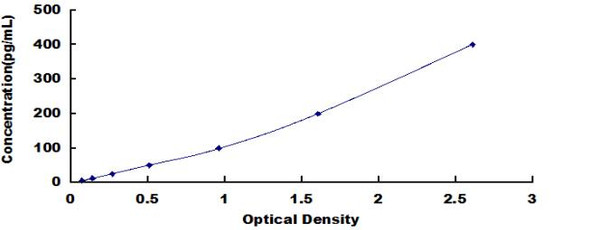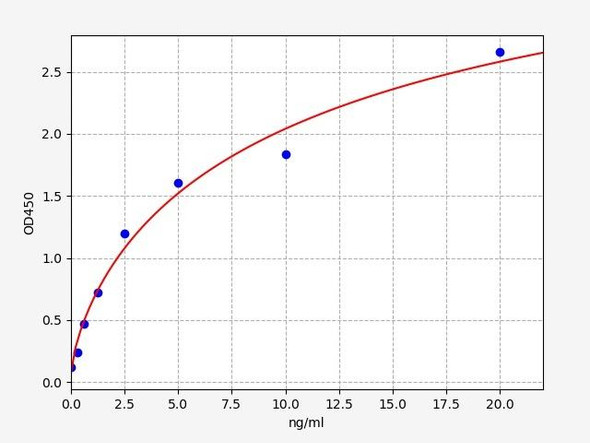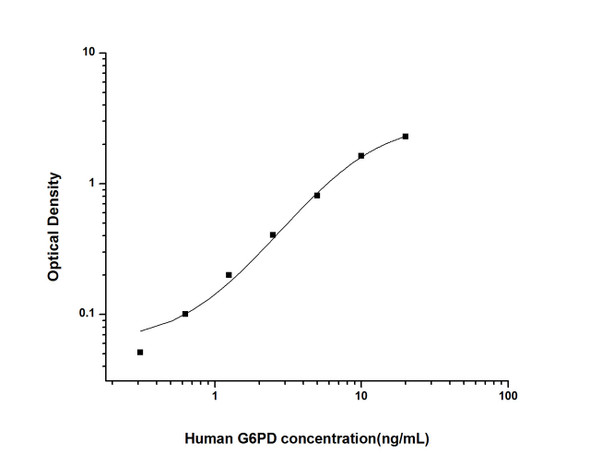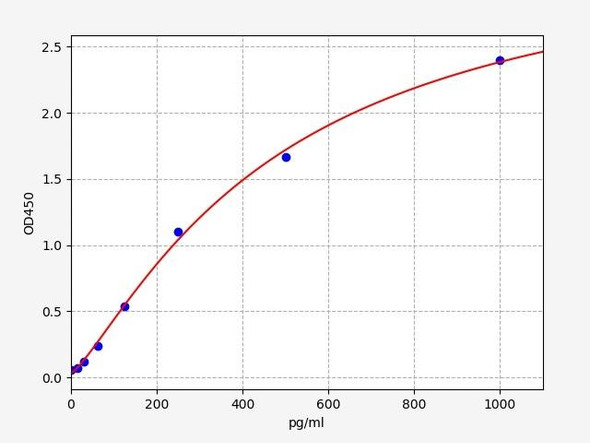Human Metabolism ELISA Kits
Human G6PD (Glucose 6 Phosphate Dehydrogenase) CLIA Kit (HUES01005)
- SKU:
- HUES01005
- Product Type:
- ELISA Kit
- ELISA Type:
- CLIA Kit
- Size:
- 96 Assays
- Sensitivity:
- 37.5pg/mL
- Range:
- 62.5-4000pg/mL
- ELISA Type:
- Sandwich
- Reactivity:
- Human
- Sample Type:
- Serum, plasma and other biological fluids
- Research Area:
- Metabolism
Description
| Assay type: | Sandwich |
| Format: | 96T |
| Assay time: | 4.5h |
| Reactivity: | Human |
| Detection method: | Chemiluminescence |
| Detection range: | 62.50-4000 pg/mL |
| Sensitivity: | 37.50 pg/mL |
| Sample volume: | 100µL |
| Sample type: | Serum, plasma and other biological fluids |
| Repeatability: | CV < 15% |
| Specificity: | This kit recognizes Human G6PD in samples. No significant cross-reactivity or interference between Human G6PD and analogues was observed. |
This kit uses Sandwich-CLIA as the method. The micro CLIA plate provided in this kit has been pre-coated with an antibody specific to Human G6PD. Standards or samples are added to the appropriate micro CLIA plate wells and combined with the specific antibody. Then a biotinylated detection antibody specific for Human G6PD and Avidin-Horseradish Peroxidase (HRP) conjugate are added to each micro plate well successively and incubated. Free components are washed away. The substrate solution is added to each well. Only those wells that contain Human G6PD, biotinylated detection antibody and Avidin-HRP conjugate will appear fluorescence. The Relative light unit (RLU) value is measured spectrophotometrically by the Chemiluminescence immunoassay analyzer. The RLU value is positively associated with the concentration of Human G6PD. The concentration of Human G6PD in the samples can be calculated by comparing the RLU of the samples to the standard curve.
| UniProt Protein Function: | G6PD: glucose-6-phosphate dehydrogenase. A cytosolic enzyme encoded by a housekeeping X-linked gene whose main function is to produce NADPH, a key electron donor in the defense against oxidizing agents and in reductive biosynthetic reactions. G6PD is remarkable for its genetic diversity. Many variants of G6PD, mostly produced from missense mutations, have been described with wide ranging levels of enzyme activity and associated clinical symptoms. G6PD deficiency may cause neonatal jaundice, acute hemolysis, or severe chronic non-spherocytic hemolytic anemia. Two splice variant isoforms have been described. The long isoform is found in lymphoblasts, granulocytes and sperm. |
| UniProt Protein Details: | Protein type:EC 1. 1. 1. 49; Carbohydrate Metabolism - pentose phosphate pathway; Cell development/differentiation; Other Amino Acids Metabolism - glutathione; Oxidoreductase Chromosomal Location of Human Ortholog: Xq28 Cellular Component: centrosome; cytoplasm; cytosol; internal side of plasma membrane; intracellular membrane-bound organelle; membrane; microtubule organizing center Molecular Function:glucose binding; glucose-6-phosphate dehydrogenase activity; identical protein binding; NADP binding; protein binding; protein homodimerization activity Biological Process: cholesterol biosynthetic process; erythrocyte maturation; glucose 6-phosphate metabolic process; glutathione metabolic process; lipid metabolic process; NADP metabolic process; NADPH regeneration; pentose biosynthetic process; pentose-phosphate shunt; pentose-phosphate shunt, oxidative branch; ribose phosphate biosynthetic process; substantia nigra development Disease: Anemia, Nonspherocytic Hemolytic, Due To G6pd Deficiency; Favism, Susceptibility To; Malaria, Susceptibility To |
| NCBI Summary: | This gene encodes glucose-6-phosphate dehydrogenase. This protein is a cytosolic enzyme encoded by a housekeeping X-linked gene whose main function is to produce NADPH, a key electron donor in the defense against oxidizing agents and in reductive biosynthetic reactions. G6PD is remarkable for its genetic diversity. Many variants of G6PD, mostly produced from missense mutations, have been described with wide ranging levels of enzyme activity and associated clinical symptoms. G6PD deficiency may cause neonatal jaundice, acute hemolysis, or severe chronic non-spherocytic hemolytic anemia. Two transcript variants encoding different isoforms have been found for this gene. [provided by RefSeq, Jul 2008] |
| UniProt Code: | P11413 |
| NCBI GenInfo Identifier: | 116242483 |
| NCBI Gene ID: | 2539 |
| NCBI Accession: | P11413. 4 |
| UniProt Secondary Accession: | P11413,Q16000, Q16765, Q8IU70, Q8IU88, Q8IUA6, Q96PQ2 D3DWX9, |
| UniProt Related Accession: | P11413 |
| Molecular Weight: | 62,468 Da |
| NCBI Full Name: | Glucose-6-phosphate 1-dehydrogenase |
| NCBI Synonym Full Names: | glucose-6-phosphate dehydrogenase |
| NCBI Official Symbol: | G6PD |
| NCBI Official Synonym Symbols: | G6PD1 |
| NCBI Protein Information: | glucose-6-phosphate 1-dehydrogenase |
| UniProt Protein Name: | Glucose-6-phosphate 1-dehydrogenase |
| UniProt Gene Name: | G6PD |
| UniProt Entry Name: | G6PD_HUMAN |
As the RLU values of the standard curve may vary according to the conditions of the actual assay performance (e. g. operator, pipetting technique, washing technique or temperature effects), the operator should establish a standard curve for each test. Typical standard curve and data is provided below for reference only.
| Concentration (pg/mL) | RLU | Average | Corrected |
| 4000 | 55311 62851 | 59081 | 59046 |
| 2000 | 25559 30159 | 27859 | 27824 |
| 1000 | 13697 13271 | 13484 | 13449 |
| 500 | 6237 6973 | 6605 | 6570 |
| 250 | 3501 2985 | 3243 | 3208 |
| 125 | 1699 1463 | 1581 | 1546 |
| 62.50 | 753 757 | 755 | 720 |
| 0 | 33 37 | 35 | -- |
Precision
Intra-assay Precision (Precision within an assay): 3 samples with low, mid range and high level Human G6PD were tested 20 times on one plate, respectively.
Inter-assay Precision (Precision between assays): 3 samples with low, mid range and high level Human G6PD were tested on 3 different plates, 20 replicates in each plate.
| Intra-assay Precision | Inter-assay Precision | |||||
| Sample | 1 | 2 | 3 | 1 | 2 | 3 |
| n | 20 | 20 | 20 | 20 | 20 | 20 |
| Mean (pg/mL) | 206.49 | 361.06 | 1587.89 | 209.52 | 373.10 | 1659.47 |
| Standard deviation | 20.19 | 38.53 | 140.69 | 26.97 | 32.68 | 124.13 |
| C V (%) | 9.78 | 10.67 | 8.86 | 12.87 | 8.76 | 7.48 |
Recovery
The recovery of Human G6PD spiked at three different levels in samples throughout the range of the assay was evaluated in various matrices.
| Sample Type | Range (%) | Average Recovery (%) |
| Serum (n=5) | 89-104 | 95 |
| EDTA plasma (n=5) | 97-109 | 103 |
| Cell culture media (n=5) | 96-110 | 102 |
Linearity
Samples were spiked with high concentrations of Human G6PD and diluted with Reference Standard & Sample Diluent to produce samples with values within the range of the assay.
| Serum (n=5) | EDTA plasma (n=5) | Cell culture media (n=5) | ||
| 1:2 | Range (%) | 95-111 | 95-112 | 86-99 |
| Average (%) | 102 | 103 | 91 | |
| 1:4 | Range (%) | 89-102 | 101-114 | 99-116 |
| Average (%) | 96 | 107 | 107 | |
| 1:8 | Range (%) | 88-101 | 88-104 | 102-115 |
| Average (%) | 94 | 95 | 109 | |
| 1:16 | Range (%) | 96-108 | 96-110 | 99-116 |
| Average (%) | 102 | 104 | 106 |
An unopened kit can be stored at 4°C for 1 month. If the kit is not used within 1 month, store the items separately according to the following conditions once the kit is received.
| Item | Specifications | Storage |
| Micro CLIA Plate(Dismountable) | 8 wells ×12 strips | -20°C, 6 months |
| Reference Standard | 2 vials | |
| Concentrated Biotinylated Detection Ab (100×) | 1 vial, 120 µL | |
| Concentrated HRP Conjugate (100×) | 1 vial, 120 µL | -20°C(shading light), 6 months |
| Reference Standard & Sample Diluent | 1 vial, 20 mL | 4°C, 6 months |
| Biotinylated Detection Ab Diluent | 1 vial, 14 mL | |
| HRP Conjugate Diluent | 1 vial, 14 mL | |
| Concentrated Wash Buffer (25×) | 1 vial, 30 mL | |
| Substrate Reagent A | 1 vial, 5 mL | 4°C (shading light) |
| Substrate Reagent B | 1 vial, 5 mL | 4°C (shading light) |
| Plate Sealer | 5 pieces | |
| Product Description | 1 copy | |
| Certificate of Analysis | 1 copy |
- Set standard, test sample and control (zero) wells on the pre-coated plate and record theirpositions. It is recommended to measure each standard and sample in duplicate. Note: addall solutions to the bottom of the plate wells while avoiding contact with the well walls. Ensuresolutions do not foam when adding to the wells.
- Aliquot 100 µL of standard solutions into the standard wells.
- Add 100 µL of Sample / Standard dilution buffer into the control (zero) well.
- Add 100 µL of properly diluted sample (serum, plasma, tissue homogenates and otherbiological fluids. ) into test sample wells.
- Cover the plate with the sealer provided in the kit and incubate for 90 min at 37 °C.
- Aspirate the liquid from each well, do not wash. Immediately add 100 µL of BiotinylatedDetection Ab working solution to each well. Cover the plate with a plate seal and gently mix. Incubate for 1 hour at 37 °C.
- Aspirate or decant the solution from the plate and add 350 µL of wash buffer to each welland incubate for 1-2 minutes at room temperature. Aspirate the solution from each well andclap the plate on absorbent filter paper to dry. Repeat this process 3 times. Note: a microplatewasher can be used in this step and other wash steps.
- Add 100 µL of HRP Conjugate working solution to each well. Cover with a plate seal andincubate for 30 min at 37 °C.
- Aspirate or decant the solution from each well. Repeat the wash process for five times asconducted in step 7.
- Add 100 µL of Substrate mixture solution to each well. Cover with a new plate seal andincubate for no more than 5 min at 37 °C. Protect the plate from light.
- Determine the RLU value of each well immediately.






